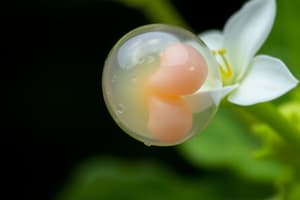Podcast
Questions and Answers
What is the outer protective layer of pollen grains called?
What is the outer protective layer of pollen grains called?
Exine
What does the Tapetum provide to developing pollen grains?
What does the Tapetum provide to developing pollen grains?
- Nourishment (correct)
- Support
- Protection
- Heat
What is the process of microspore formation from pollen mother cell (PMC) called?
What is the process of microspore formation from pollen mother cell (PMC) called?
Microsporegenesis
Sporogenesis tissue undergoes meiosis to form microspore tetrads.
Sporogenesis tissue undergoes meiosis to form microspore tetrads.
How many wall layers surround the microsporangium?
How many wall layers surround the microsporangium?
Pollen grains are spherical and covered by a two-layered _____
Pollen grains are spherical and covered by a two-layered _____
Flashcards are hidden until you start studying
Study Notes
Reproduction in Plants: Flowering and Embryo Development
- Reproduction involves processes such as pollination, fertilization, and the development of embryos.
- Apomixis is an asexual reproductive mechanism in plants, allowing seed production without fertilization.
Structure of Anther
- Anther is bilobed and consists of two lobes that are dithecous, separated by a longitudinal groove.
- Microsporangium is located at the corners of each theca, with two in each lobe.
- Each microsporangium features four wall layers:
- Epidermis (outermost layer)
- Endothecium (provides support during dehiscence)
- Middle layer
- Tapetum (innermost layer, nourishes developing pollen grains)
Pollen Grain Development
- Young anther experiences sporogenesis, where pollen mother cells (PMC) form at the center of each microsporangium.
- Microspore formation occurs through meiosis, resulting in a microspore tetrad, where each cell has the potential to develop into a pollen grain.
- PMC leads to pollen grains, which represent male gametes.
Pollen Grain Structure
- Pollen grains are spherical and have a two-layered structure:
- Exine (outer layer) is hard, made of sporopollenin, and is highly resistant to environmental conditions.
- Exine can withstand extreme temperatures, acidity, alkaline conditions, and enzymatic degradation.
Studying That Suits You
Use AI to generate personalized quizzes and flashcards to suit your learning preferences.




